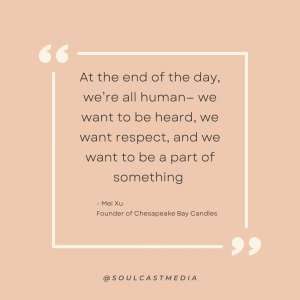Cross-Cultural Communications For Career Success
As you advance through your career, you will want to exercise your cross-cultural communication skills. The reason for this is there are many people you will meet who may have differing points of view, as well as expectations due to their culture. The more you are able to successfully communicate across cultures, the more growth you will find in your career.
 Our CEO and Founder, Jessica Chen, recently hosted a Soulcast Media | LIVE event on LinkedIn where she interviewed Founder and CEO of Chesapeake Bay Candle, Yes She May, and best-selling author, Mei Xu.
Our CEO and Founder, Jessica Chen, recently hosted a Soulcast Media | LIVE event on LinkedIn where she interviewed Founder and CEO of Chesapeake Bay Candle, Yes She May, and best-selling author, Mei Xu.
They shared key tips and personal experiences on how cross-cultural communications are key for career success. This Soulcast Media | LIVE event is brought to you by our amazing sponsors at NeedThat™
NeedThat™ is a modern independent publishing company that wants to cut through the noise of everyday consumerism.
The best products are the ones that are referred to us by our friends and family, people who we can trust. NeedThat is connecting our readers to make smarter and informed purchasing decisions.
Learning how to navigate cross-cultural communications will help you become an asset to your team and a better leader.
1. Communication
It may seem simple, but the truth is, having strong communication skills will help you as you navigate cross-cultural communications. Effective communication is more than just speaking, it is also listening and understanding. When you are able to effectively communicate with someone cross-culturally, you will be able to listen and understand what they are trying to say.
During the Soulcast Media | LIVE, Mei shared a story about her experience working with Target when she first started Chesapeake Bay Candles. She talked about how her cultural background played a part in misinforming Target of her production capabilities. Target asked Mei to fulfill an order in a set amount of time. Mei knew she wouldn’t be able to deliver this order, but said she could. The reason for this is in her culture saying no meant you weren’t actually trying. However, the executives at Target felt she had lied to them when the order hadn’t been fulfilled. This was simply a case of cultural miscommunication.
There are several ways you can navigate cross-cultural communications:
- Keep Everyone Informed – One easy way to ensure there are no miscommunications is to keep everyone informed every step of the way. This will help avoid confusion. For example, if you are leading a team through a project, you can give weekly updates to the leaders within your organization. Be sure to include anyone who will be impacted by the project. In this way, no one will be surprised at the progress of the project because everyone was informed the entire way through.
- Set Boundaries – Every culture has different expectations when it comes to the workplace. It is important for you to set clear boundaries before work begins. This is important because if you don’t set those boundaries, the expectations may not be met and this can leave people upset and confused. For example, if you are in charge of speaking with the team from another country, and you are only reachable during your business hours – you need to communicate what those are. If you don’t, people may be trying to reach you and think you aren’t working on their very important project. However, if you tell them you are only available between 9am-5pm EST on your cell or by email- they will know when and how to reach you.
- Be A Problem Solver – The last thing any team leader wants to hear is simply the problem. Coming to the table with a problem AND possible solutions will not only build your credibility, but will also show good faith with those you are working with. And this is important when you are working cross-culturally because it shows you are being transparent. For example, if you are working on a project and the materials you need to finish are back-ordered, instead of simply saying, unfortunately, we can’t finish because our materials are back-ordered. You can say, the materials we need to finish are back-ordered, but I’ve found three other suppliers who have what we need in stock. Here is how much each one will cost to deliver. See how being a problem solver shows transparency, but also builds your credibility as a critical thinker?
Communication is vital when working with cross-cultural teams. You will want to make sure you are keeping everyone informed, communicating clear boundaries, and coming to the table with problems and solutions.
![]()
2. Find Common Ground
When working with cross-cultural teams, one way you can build strong relationships is by finding common ground. During the Soulcast Media | LIVE, Mei shared she was trained in diplomacy and one of her biggest tricks of the trade was finding common interests.
Finding common interests can help you when you are communicating with someone from another culture. There are several ways to find common ground.
- Be observant – One way to find common ground is to be observant. What this means is when you are with someone, whether you are in-person or in a virtual setting, you can notice something about the person. For example, if you are in a zoom meeting with a person and notice they have several books on their bookshelf, you can ask them – what is your favorite book? Most people will happily tell you about their favorite book. Or, if you are in person, you can tell the person you like their jacket or their shoes. Simple observations can go a long way.
- Small Talk – A lot of people are afraid of small talk, but the truth is, small talk is how you get to know someone. Small talk will help you find common interests and build relationships. For example, almost everyone loves to talk about their favorite restaurants, or their pets, or even crazy weather patterns. Find something the other person likes to talk about, and go from there. You’ll be surprised how much you actually have in common.
- Ask Questions – Asking questions can help you find common ground with another person. When you ask questions, you show you are sincere in getting to know someone. For example, you can ask about their background. Things like where they went to school or what their major in college was are simple questions most people are happy to answer. When you ask questions, you can then follow up and talk about yourself. This is a way for both of you to build a stronger relationship with each other.
3. Respect
Respecting others is the key to cross-cultural communications. This means being intentional about listening, showing your humanity, and not assuming anything about the other person.
At the end of the day, we’re all human— we want to be heard, we want respect, and we want to be a part of something – Mei Xu
There are several ways you can show respect while communicating.
- Active Listening – Active listening means giving the speaker your full attention. It also means getting rid of any distractions, being prepared to give thoughtful feedback, and asking clarifying questions. When you actively listen, you show respect to the other person. For example, if someone is explaining how a process works and you aren’t sure you understand – instead of interrupting them, you can ask a responsive question. You can say, I think what you are trying to say about xyz is this, am I correct? In this way, you are showing respect in your listening and communication.

- Don’t Assume – When you are speaking to people from different cultures it is important you don’t assume they know exactly what you are talking about. What this means is recognizing the person you are speaking to may not know phrases, references, and other common knowledge ideas you may have. For example, simple abbreviations may not translate to everyone. Something like saying, we plan to have this done EOD – may not make sense to everyone. Instead, be sure not to include anything that could be confusing to someone else. Simply say, we plan to have this done by the end of the day. What is a common phrase for you, may not be for everyone else. Be sure to not assume everyone knows what you know.
- Everyone is human – One of the most important things to remember when speaking to people from other cultures is to remember everyone is human. What this means is, everyone might not understand everything the first time. Everyone will make mistakes, including you. And everyone will fall victim to miscommunication. However, when you remember we are all humans, you are able to be respectful and patient in every interaction.
Being respectful in all of your communications, whether they are cross-cultural or not, will build your credibility. Pay close attention to how you interact and make sure it is always respectful.
In the end, bolstering your cross-cultural communications skills through effective communication, finding common ground, and respectful interactions will set you up for career success.
If you would like to see the full LIVE version of Jessica and Mei’s conversation, check out Jessica’s Youtube Channel.
__
Whenever you’re ready, there are 3 ways we can help you:
- Discover your communications style so you know where to start. Over 4,000 people have found theirs here.
- Attend our monthly communication workshop to build communications confidence (new topics: public speaking, advocating for yourself, building credibility, etc) here.
- Get your brand in front of 43k+ people by sponsoring our newsletter or Soulcast Media | LIVE LinkedIn events [contact: hello@soulcastmedia.com]











